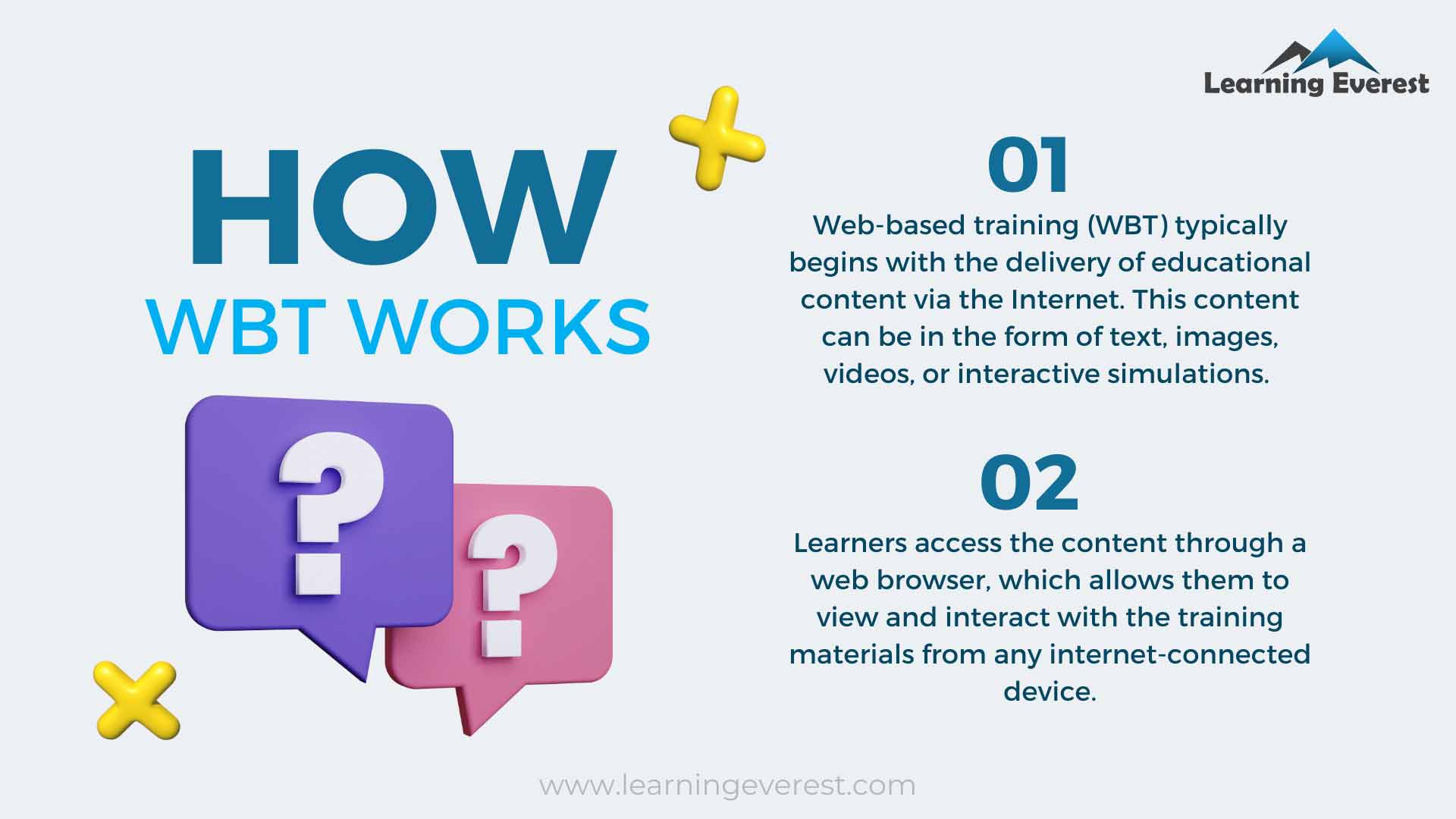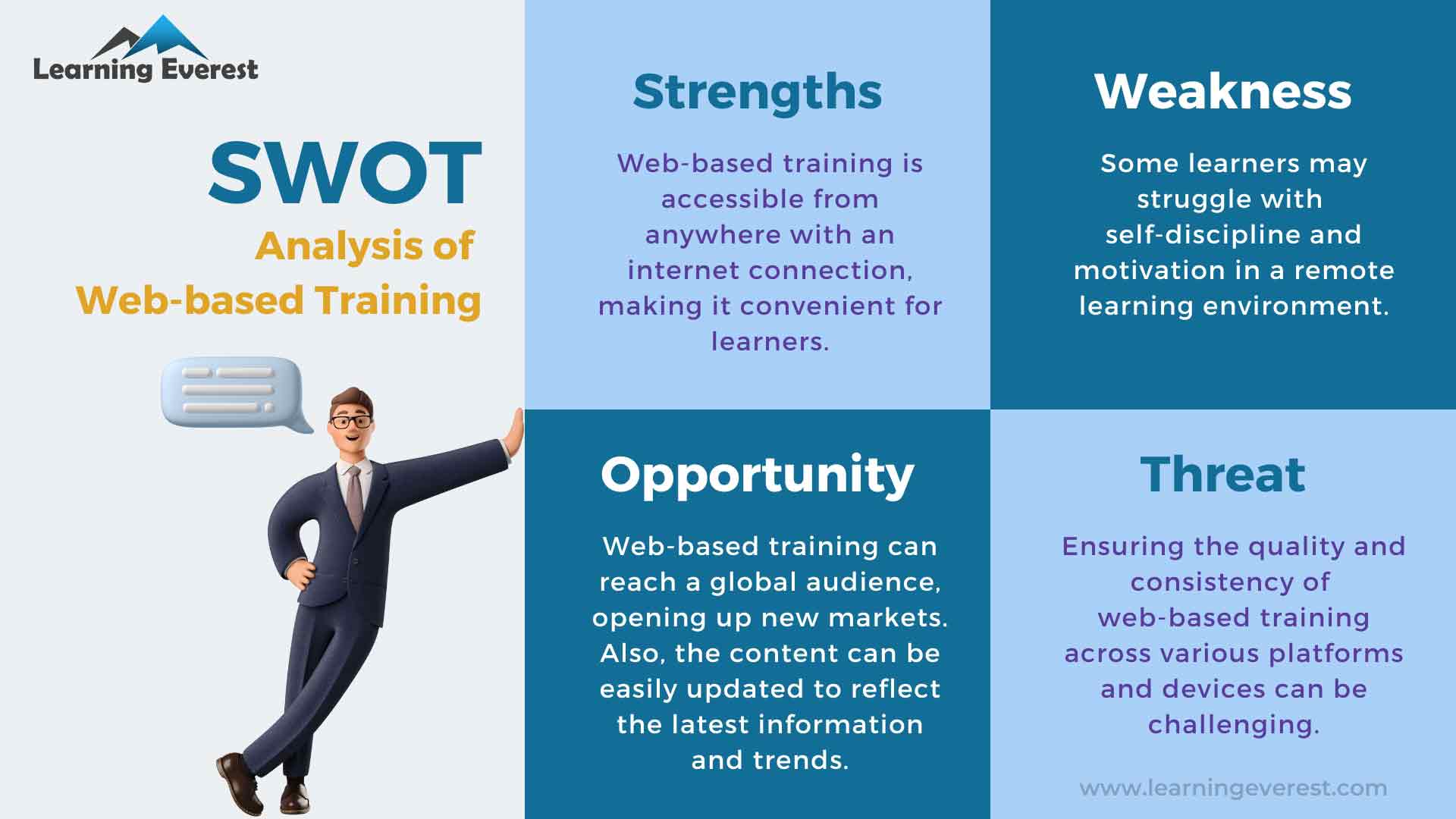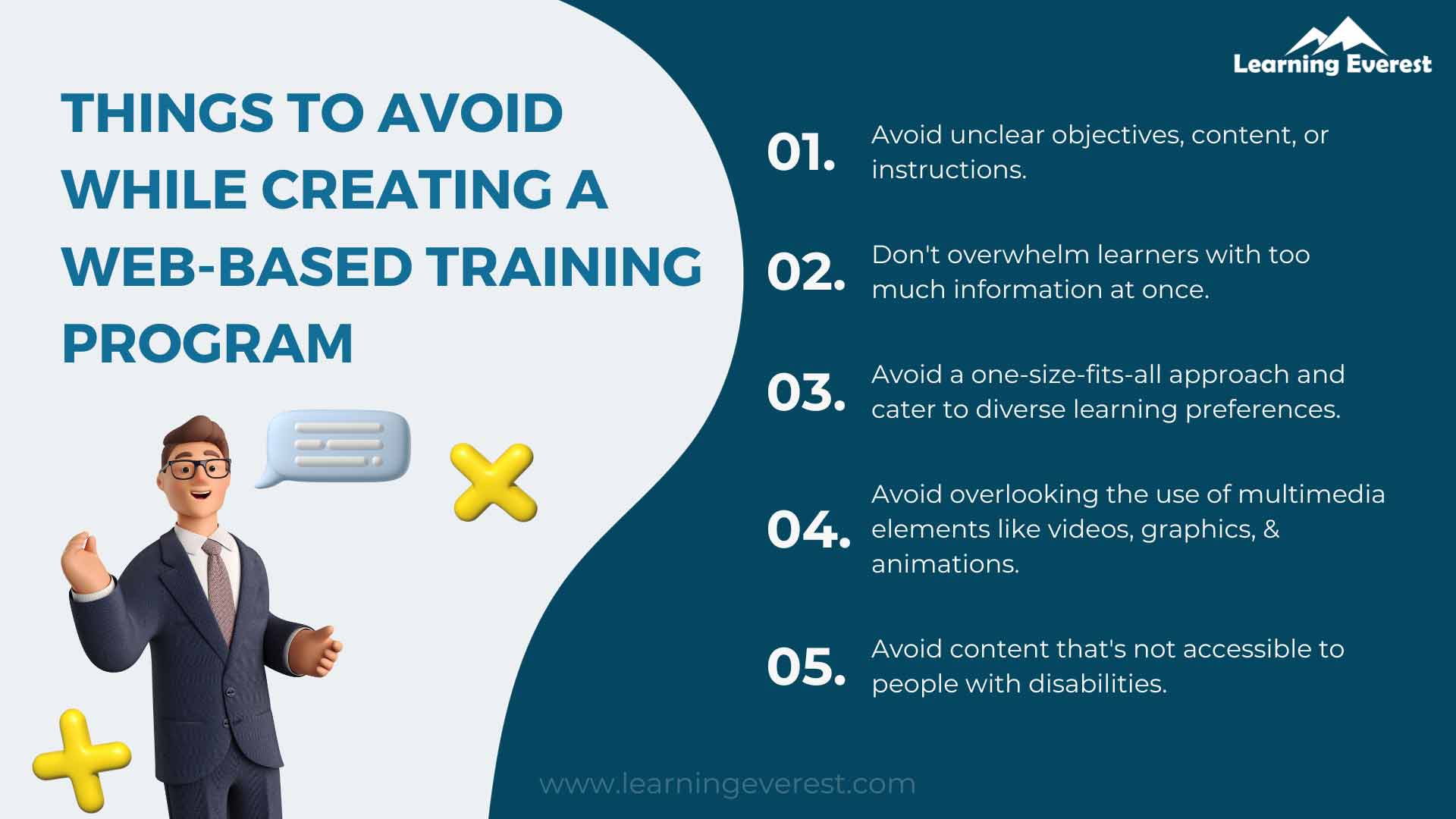Table of Contents
- WBT का मतलब
- वेब-आधारित प्रशिक्षण के प्रकार
- Some web-based training platforms
- Why is web-based training (WBT) becoming popular?
- How to create a web-based training (WBT) module?
- The benefits of using web-based training (WBT)
- Infographics
- Frequently Asked Questions (FAQs)
- What is web-based training?
- What are web-based training platforms?
- How effective is web-based training?
- How do you create a web-based module?
WBT meaning
WBT stands for Web-Based training. It is also known as Internet-Based Training (IBT). It is online learning for employees who want to upskill at their jobs. In layman’s terms, web-based training takes place online or over the internet. Also referred to as e-learning, this type of training has gained widespread popularity in recent years due to the rapid advancement in information and communications technology.

How WBT Works
Types of web-based training
There are three types of web-based training. Let us discuss them in detail:
- Synchronous web-based training: Synchronous training is an e-learning method that allows learners to connect and learn the same thing at the same time. In synchronous learning, learners and instructors are engaged in course content at the same time using online platforms. This engagement allows for easy give-and-take discussion and a learning environment that can be highly social and interactive. Examples include online meetings, webinars, teleconferencing, and online tutoring via Zoom, Microsoft Teams, Skype, etc.
- Asynchronous web-based training : Asynchronous training takes place without real-time instructions. Instead, the instructors generate online content in advance, and learners engage with it as per their schedules. Contents are taught in a consistent manner using standard training. It makes sure that every learner receives standardized knowledge. Pre-recorded webinars, online eLearning courses, and video tutorials are examples of asynchronous training.
- Blended web-based training: In blended training, there are elements of both synchronous and asynchronous learning. It involves real-time interactions between the instructor and learners, either in-person or online. Also, some of the training is self-paced according to one’s schedule.
Some web-based training platforms
There are multiple platforms, such as:
- EdApp
- Coursera
- Shaw Academy
- eDX
- GoSkills
- SkillShare
- Gyrus
- AdaptiveU
- Khan Academy
- 360Learning
Why is web-based training (WBT) becoming popular?
Web-based training is an excellent choice for employees who want to upskill by learning concepts and skills that are complex and technical. Therefore, employees can enroll in a web-based training program to increase knowledge in specific fields they might lack during work. Employees can swiftly upskill themselves by engaging in synchronous sessions with experienced instructors and asynchronous activities like reading articles and interacting with content provided in an LMS.
These activities may sound passive, but they can be active components of learning with doable activities, such as engaging in case studies, and participating in team activities, games, or simulations. These activities transform their previously gained information into skills. This increases the total productivity of the organizations while assisting trainees in becoming highly trained workers. With the help of web-based training tools, organizations can train their employees better, faster, and more efficiently.

SWOT Analysis of Web-based Training
How to create a web-based training (WBT) module?
To create web-based training that is engaging and effective in the long run, here are a few steps you need to follow:
Step 1: Identify the audience’s training needs
Do employees need to develop leadership, interpersonal, or job-specific technical skills? Effective training programs consider questions like, who needs training? Who will facilitate the training? On which platform will the training take place? How will knowledge be transferred to the job? How will the training be evaluated? It is necessary first to determine the training needs in whatever areas they require instruction. This will make it simple for you to provide relevant training that satisfies those demands and inspires your learners to study and fill in any knowledge and skill gaps.
Step 2: Set proper learning objectives with motivation
Besides the mission to train the employees effectively, web-based training should be tied to larger business objectives. This will give the organization a direction and focus on what you need to do and why. One could set SMART goals, which means setting learning goals that are specific, measurable, achievable, relevant, and time-bound.
Step 3: Adopt the best training software
Web-based training software tools should fulfill all the training needs. Make sure to visit software review sites to find and compare the top software on the market before making up your mind.
Step 4: Choose the right course
The crux of web-based training is online learning. You may teach your employees job-related information with these online training programs, giving them the tools they need to perform more quickly and effectively. Make sure the course you select for the training is professionally prepared, covers a wide range of topics, incorporates examples and scenarios from real-world situations, and is the appropriate duration.
Step 5: Implement the training
One can share, assign learning journeys, launch pop-quizzes for evaluation, facilitate collaborative learning, track learners’ progress, and view detailed stats to implement the training.
Step 6: Ask for feedback
Feedback from the audience provides constructive ideas you may have never thought of earlier. Use structurally designed surveys to collect course feedback. This will help to identify rooms for improvement, if any, in your course and deliver a better learning experience.

Things to Avoid While Creating a Web-Based Training Program
The benefits of using web-based training (WBT)
Web-based training is gaining fast popularity for its effectiveness and deliverables. Most corporates use web-based training to get the desired results within the given timeframe. The benefits of using WBTs are:
- The flexibility of learning: Web-based training provides you the convenience of accessing the training from any place at any time.
- Promote effective learning and retention: Employees communicate and use problem-solving and critical reasoning skills while learning skills. Training sessions are customized and designed to make them learner-centric. It promotes better understanding.
- Continuous learning: The flexibility, ease, and convenience make it easy to access learning programs that are targeted, easy to comprehend, and effective.
- Connects distant learners: The use of web-based learning techniques makes it feasible to communicate with learners who are located all over the world. Any learner around the globe can participate in the same learning environment.
- Learning while at work: Employees need not take a leave or a break to learn new skills. Web-based training makes it simple by making the courses available online, anytime, anywhere.
- Accessible via multiple platforms: One of the other benefits of using WBT is that it can be accessed on multiple platforms like Windows, PDA, UNIX, MAC, and other mobile devices.
- Individual-oriented: Web-based training might not offer an environment that fosters social skills development. But employees who find it challenging to participate in physical interactions or debates and do not like socializing can be comfortable with learning alone online on their own.
- Higher retention: Using digital resources, including presentations and multimedia that includes images, videos, and audio, learners learn more than any traditional learning method.
- Instant feedback: Web-based training provides learners with instant feedback that helps them evaluate their growth and motivates them. The feedbacks offered by their fellow online learners and the instructors bring greater quality to the overall learning experience.
The latest forms of web-based training (WBT) are highly targeted and deliver great flexibility, adequate understanding, and the freedom to learn at a particular pace and time. Although both CBT (Computer-Based Training) and WBT are in demand, WBT gives greater flexibility of accessing it anywhere, anytime, and on devices such as iPads, smartphones, laptops, etc., which have broadband connectivity.
Infographics

WBT meaning
Frequently Asked Questions (FAQs)
What is web-based training?
WBT stands for Web-Based training. It is also known as Internet-Based Training (IBT). It is online learning for employees who want to upskill at their jobs.
What are web-based training platforms?
There are multiple platforms such as MAC, UNIX, PDA, mobiles, etc.
How effective is web-based training?
Employees can enroll in a web-based training program to increase knowledge in specific fields they might lack during their work.
How do you create a web-based module?
To create web-based training that is engaging and effective, follow these steps: identify the audience’s training needs, set proper learning objectives with motivation, adopt the best training software, choose the right course, implement the training, and ask for feedback.





